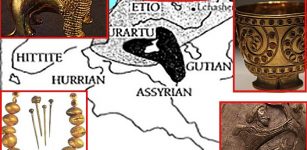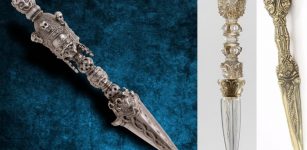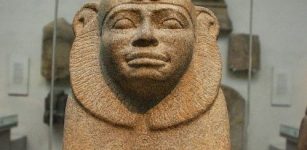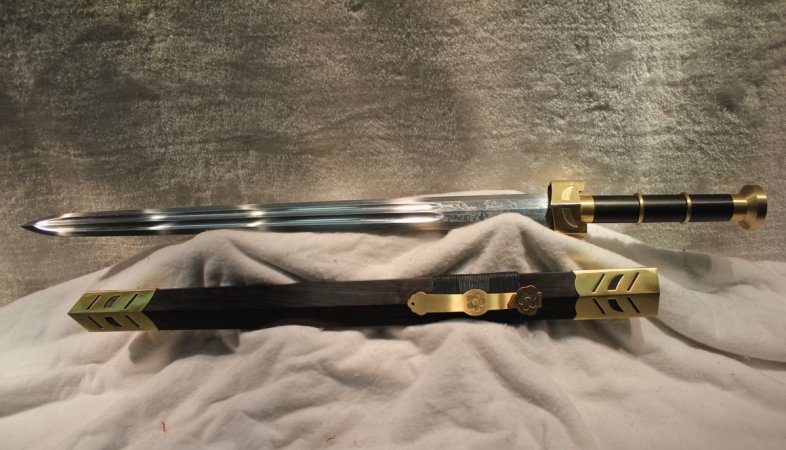Ancient History Of Chinese Swords
Rafael - AncientPages.com - Just like China, the swords that were utilized for battles also had a long and rich history. The earliest known Chinese swords from the period were made specifically of stone and were utilized in the prehistoric era. Bronze Chinese swords have been traced back to the Shang Dynasty where these types of daggers and other weapons were mostly used.
Folded Steel Chinese Han Sword double edge, sharp on both sides, brass fittings. Credit: Katanas For Sale
In the mid-third century BC, long bronze swords suddenly appeared yet the later swords that appeared in ancient China were made of steel or iron. These types of metals were wrought and never cast, and the swords during that period usually featured a length of about seventy to a hundred centimeters, although there were numerous long swords that have been found. These individuals have classified their Chinese swords into two main types: the Jian, which have dual-edged blades, and the Dao which are the single-edged pieces.
History Of The Chinese Swords
In 1045 BC to 256 BC during the Zhou Dynasty, the Chinese swords commonly appeared as short, single-handed and double-edged straight blades made of bronze. When the Qin Dynasty arrived, the swords were extended and were also developed into two-handed blades.
The Han Dynasty was when the very first single-edged weapons were created, as well as those with steel blades. This newly developed design for the Chinese swords remained prominent until the Song Dynasty where a few adjustments were made to fit the requisites of the army during that period.
During the Yuan Dynasty, the Turko-Mongol saber was introduced as the primary weapon for soldiers and civilians; its shape became the basis for the Chinese blades, Liuyedao and the Yanmaodao of the later dynasties. Lastly, in the late Qing Dynasty, the more common Niuweidao was eventually developed. It was a single-handed, single-edged Chinese sword that featured a heavy blade with a unique-looking flaring tip. It was never issued to the army or the military and was primarily a weapon for the defense of the civilians.
The Jian Sword
The Jian is a straight, double-edged Chinese sword that was a weapon used during the last 2500 years in ancient China. The first mention of the Chinese Jian dates back to the seventh century BCE – the Spring and Autumn period; one of the earliest samples of this type of sword was the Sword of Goujian. The classic single-handed versions of the Jian featured blades that went up to forty-five to eighty centimeters in length; its average weight was about 1.5 to 2 pounds for a Chinese sword that measured an average of seventy centimeters.
Historical And Modern Use Of The Jian
The Jian in different periods featured different lengths, sizes, and weight. Though there are distinct characteristics to the Chinese blade, its main purpose was to cut and thrust adequately towards a target. There are also numerous schools of swordsmanship that teach the Jian yet the styles vary as well yet the general purpose and use of the blade are still the same. The historical Jian wielders engaged in a test cutting process called the Shizhan, and they would practice and hone their skills of using the Chinese blade on targets known as caoren.
See also:
Secrets Of Ninja Swords – Favorite Weapon Of The Shinobi
Samurai Swords: Katana And Wakizashi And Their Long Tradition
Sacred Regalia Of Japanese Emperor: Sword, Mirror And Jewel In Ancient Japanese Tradition
Today, a large number of Chinese martial arts such as the Taijiquan have practitioners that still progressively train extensively using the Jian. Most of the practitioners claim that having expertise in the techniques of the Jian is the highest physical expression of their Kung-Fu. Most of the Chinese Jian that are present are the washu jian or the flexible tai chi which are primarily utilized for performance or ceremonial purposes only.
Appearance Of The Jian
The Jian has guards or hilts that protect the wielder’s hand especially when the opposing blade aims to poke or thrust along this area. The guard’s shape can be characterized as having short wings that point either backward or forward; it also has a handle positioned right behind the guard which helps provide the wielder with a better grip for both or just one hand. These grips are often made of fluted wood or sometimes covered in rayskin where most are also overlaid with a cord.
The ends of its handle feature a pommel which is necessary for proper balance; it also prevents the handle from sliding through the wielder’s grip, and it is also a good piece for tapping or striking the opponent. During the Ming Dynasty, these weapons commonly passed through a pommel and in the Qing Dynasty, it would pass through a hole in the weapon’s grip. Contemporary Chinese swords usually link the tassel to the pommel’s end; historically, the ancient Chinese would make use of lanyards that would allow the user to retain the sword during battles.
Dao Blades
The Dao are single-edged Chinese blades that are mainly used for chopping and slashing; its most known form is the Chinese saber though the pieces with much larger blades are usually referred to as the Chinese Broadswords. In China, this weapon is considered to be one of the four classic weapons together with the spear, staff, and the sword.
Historical And Modern Uses Of The Dao
The Dao became one of the most popular pieces among the cavalry during the Han period. This was because the Dao was extremely sturdy and was superior when it came to chopping targets. In this day and age, the martial arts schools in China still continue to train participants extensively with this blade, seeing it as a powerful and very effective conditioning tool, as well as a very versatile weapon. Training with the Dao will also teach its participants proper self-defense which can eventually be utilized with any day to day life items.
There are other variations of this Chinese Dao and it includes the large Bagua Dao and the long-handled Pudao. Some of the acquired blades from the Qing Dynasty survived history and even had numerous descendants see military action during the twentieth century. The Dadao was commonly utilized by a couple of Chinese Militia against the Japanese invaders during the Second Sino-Japanese battles. The Miao Dao is the descendant of the Chang Dao and it was also utilized during this period.
Written by – Rafael - AncientPages.com Contributor
Copyright © AncientPages.com All rights reserved. This material may not be published, broadcast, rewritten or redistributed in whole or part without the express written permission of AncientPages.com
Expand for referencesMore From Ancient Pages
-
 Hades – Land Of The Dead In Greek Beliefs Offered Punishment And Paradise Full Of Harmony
Featured Stories | Aug 15, 2019
Hades – Land Of The Dead In Greek Beliefs Offered Punishment And Paradise Full Of Harmony
Featured Stories | Aug 15, 2019 -
 Incredible Ancient Star Map Depicting Our Galaxy Is Hidden In Africa
Featured Stories | Aug 4, 2018
Incredible Ancient Star Map Depicting Our Galaxy Is Hidden In Africa
Featured Stories | Aug 4, 2018 -
 31,000-Year-Old Skeleton Missing Foot May Show Oldest Amputation
Archaeology | Sep 7, 2022
31,000-Year-Old Skeleton Missing Foot May Show Oldest Amputation
Archaeology | Sep 7, 2022 -
 Human Skeleton Dated To Parthian Era Unearthed At Tepe Ashraf In Iran’s City Of Isfahan
Archaeology | Jul 25, 2020
Human Skeleton Dated To Parthian Era Unearthed At Tepe Ashraf In Iran’s City Of Isfahan
Archaeology | Jul 25, 2020 -
 Mysterious Hakkari Stelae: Were They Carved By Inhabitants Of Ancient Kingdom Of Hubushkia?
Artifacts | Nov 15, 2018
Mysterious Hakkari Stelae: Were They Carved By Inhabitants Of Ancient Kingdom Of Hubushkia?
Artifacts | Nov 15, 2018 -
 God Ptah ‘Lord Of Memphis’ Was Among The Most Revered Creator Gods Of Ancient Egypt
Egyptian Mythology | Apr 17, 2018
God Ptah ‘Lord Of Memphis’ Was Among The Most Revered Creator Gods Of Ancient Egypt
Egyptian Mythology | Apr 17, 2018 -
 Ancient Indigenous Carvings On Boab Trees – Time To Rescue Ancient Art Before Trees Disappear
Archaeology | Oct 12, 2022
Ancient Indigenous Carvings On Boab Trees – Time To Rescue Ancient Art Before Trees Disappear
Archaeology | Oct 12, 2022 -
 4,500-Year-Old Board Games And Game Pieces Unearthed At Gath
Archaeology | Jun 19, 2022
4,500-Year-Old Board Games And Game Pieces Unearthed At Gath
Archaeology | Jun 19, 2022 -
 Trialeti Culture: Ancient Caucasian People Who Still Hold Their Secrets
Civilizations | Jul 8, 2017
Trialeti Culture: Ancient Caucasian People Who Still Hold Their Secrets
Civilizations | Jul 8, 2017 -
 They Spoke The Language Of The Gods – Keepers Of Sacred Ancient Knowledge – Part 1
Civilizations | May 22, 2018
They Spoke The Language Of The Gods – Keepers Of Sacred Ancient Knowledge – Part 1
Civilizations | May 22, 2018 -
 Why Didn’t Pythagoras And His Followers Eat Beans?
Ancient History Facts | Jan 18, 2019
Why Didn’t Pythagoras And His Followers Eat Beans?
Ancient History Facts | Jan 18, 2019 -
 Amazing Painted Throne Room Of A Powerful Moche Queen And An Unknown Large Structure Discovered In Peru
Archaeology | Oct 4, 2024
Amazing Painted Throne Room Of A Powerful Moche Queen And An Unknown Large Structure Discovered In Peru
Archaeology | Oct 4, 2024 -
 Mysterious Fossilized Antarctic Forest May Offer Evidence Of The Great Flood – But Some Facts Speak Against This Theory
Archaeology | Dec 27, 2017
Mysterious Fossilized Antarctic Forest May Offer Evidence Of The Great Flood – But Some Facts Speak Against This Theory
Archaeology | Dec 27, 2017 -
 Phurba Dagger: Magical Weapon That Restrains Evil And Harmful Occult Forces
Artifacts | Mar 16, 2019
Phurba Dagger: Magical Weapon That Restrains Evil And Harmful Occult Forces
Artifacts | Mar 16, 2019 -
 On This Day In History: Declaration Of Independence Of The Mexican Empire Is Drafted – On Sep 28, 1821
News | Sep 28, 2016
On This Day In History: Declaration Of Independence Of The Mexican Empire Is Drafted – On Sep 28, 1821
News | Sep 28, 2016 -
 Tooth Analysis Reveal Nebraska Resembled A Dry Savanna 18 Million Years Ago
Archaeology | Jun 8, 2022
Tooth Analysis Reveal Nebraska Resembled A Dry Savanna 18 Million Years Ago
Archaeology | Jun 8, 2022 -
 Taharqa – The Most Powerful Of The Black Pharaohs
Featured Stories | Jan 29, 2016
Taharqa – The Most Powerful Of The Black Pharaohs
Featured Stories | Jan 29, 2016 -
 Constructing Noah’s Ark – Re-Examination Of The Original Biblical Wording
Biblical Mysteries | Feb 1, 2018
Constructing Noah’s Ark – Re-Examination Of The Original Biblical Wording
Biblical Mysteries | Feb 1, 2018 -
 First Known Depiction Of The Biblical Heroines Deborah And Jael Unearthed On 1,600-Year-Old Mosaics
Archaeology | Jul 6, 2022
First Known Depiction Of The Biblical Heroines Deborah And Jael Unearthed On 1,600-Year-Old Mosaics
Archaeology | Jul 6, 2022 -
 Fire Reveals Notre-Dame De Paris Cathedral Was Historical First In Using Iron Reinforcements In The 12th Century
Archaeology | Mar 17, 2023
Fire Reveals Notre-Dame De Paris Cathedral Was Historical First In Using Iron Reinforcements In The 12th Century
Archaeology | Mar 17, 2023


